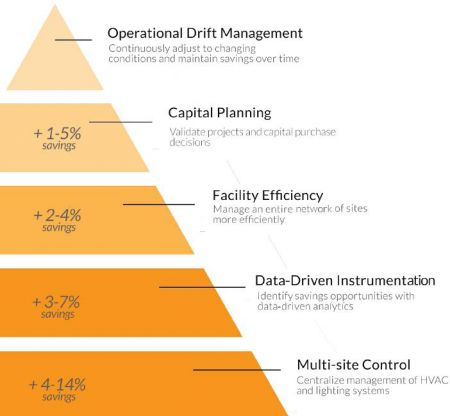In its first decade of existence, GridPoint raised nearly $300 million in VC funding, bought a half-dozen smaller startups -- and then ousted CEO Peter Corsell, laid off much of its staff, and more or less disappeared from view in the smart grid, EV charging and home energy analytics fields it had sought to command. At that point, many industry observers, including Greentech Media, wrote it off as a has-been from the go-go green technology fundraising days of the prior decade.
But in the past two years, the Arlington, Va.-based startup has raised $22 million in new funding, hired a new CEO, and rebuilt itself as a commercial building energy management player, expanding on the business it acquired when it bought startup ADMMicro.
Now GridPoint has about 11,000 commercial building sites under its management, with a combination of energy monitoring hardware, portfolio management software, and a services arm to help achieve and maintain efficiency improvements for customers like big-box retail, fast-food restaurants and pharmacy chains.
These are some of the harder-to-reach types of buildings when it comes to energy management. As we’ve noted in previous coverage, the sophisticated building automation systems used by large commercial and industrial buildings tend not to scale down very well to smaller properties like these, and small businesses can’t afford to dedicate employee time and effort to keeping up day-to-day efficiency goals.
But with a growing list of customers, and newly announced partnerships with demand response and energy management giant EnerNOC and security company ADT, it appears that GridPoint is convincing some deep-pocketed partners that it has something worth building on.
“We are a completely different company,” Todd Raba, GridPoint’s CEO and former top executive at Berkshire Hathaway companies Johns Manville Co. and MidAmerican Energy Holdings, said in an interview last month. “We have exited all of our legacy businesses, and are completely focused on energy management and enterprise energy solutions.”
While Raba declined to talk about GridPoint’s current financial situation, in terms of revenues, profitability or cash on hand to expand its business, “We have a very clear visibility into how we can scale very quickly and very competitively,” he said.
Hardware, software and services as the ‘three legs of the stool’
“When we talk about our offering, we talk about three legs of the stool,” he said. Those include hardware to monitor and control key energy-using equipment like HVAC systems, refrigerators, ovens and lighting systems, a cloud-based software management platform to analyze and plot out least-cost interventions to reduce energy bills and keep up on maintenance, and importantly, service personnel to help its corporate clients put these tools to use.
“Particularly with the smaller entities that don’t have a dedicated staff, we’re providing that support to them, helping them set lighting schedules, temperature set points, and the other things a more sophisticated customer might do on their own,” he said.
GridPoint has been able to show significant energy cost reductions in its initial deployments, ranging from 10 percent for the 1,751 stores it has set up for an 8,000-site pharmacy chain, to 27 percent for the 23 sites it has gone into for an 1,100-site big box retailer, according to its statistics for typical results after one year in operation.
But like many other building energy management systems, GridPoint doesn’t rely on energy savings alone to pay back the costs of deploying its technology. Being able to detect and prevent equipment failures, optimize maintenance for multi-site customers, and help customers plan more cost-effective future asset expenditures adds to the underlying efficiency proposition, though in harder-to-quantify ways, as the chart below indicates.

In combination, these can lead to returns on investment that pay for the cost of GridPoint’s service within about 24 months, Raba said. GridPoint typically starts with a six-month pilot in a subset of stores, followed by a more widespread deployment, as it has recently publicized with Midwestern Burger King and Hardee’s restaurant franchise owners.
These are not values lost on the competition, of course. Big energy services companies (ESCOs) like Siemens, Schneider Electric, Honeywell, Johnson Controls, Ecova and Elster’s EnergyICT are tackling the small to medium-size building market with similar propositions. Smaller contenders like Verisae are gaining ground by specializing in specific verticals like grocery store chains, while energy disaggregation startups like PlotWatt are using single-building energy data feeds to diagnose wasted power and faulty equipment without multiple sensors.
From the enterprise viewpoint, remote energy audits from software specialists like FirstFuel, Retroficiency and Pulse Energy (acquired by EnerNOC) can also provide important insights on building portfolios. But a wraparound hardware, software and services approach is rarer for the small and medium-size buildings market, Raba said. “There are folks that do software, that do metering, that do controls -- but there’s no one who does the whole enchilada the way GridPoint does.”
Expanding reach with EnerNOC, ADT
GridPoint’s latest partners indicate new opportunities for this approach. Take its partnership with EnerNOC, which aims to marry GridPoint’s granular building systems data with EnerNOC’s software to link energy consumption to grid services and energy market opportunities.
“Our traditional customers, the enterprise customers like Hardee's, have similarly situated facilities across a broad geography,” Raba said. “But the other part of our strategic plan was to approach the larger, more complex individual facilities,” which tend to already have energy management technology in place. Last year GridPoint announced its ability to connect its cloud-based software to building automation systems using Honeywell’s Niagara platform, an industry-standard technology for building automation systems.
EnerNOC has been looking for some time for a partner to help it expand into the small and medium-size built environment, according to conversations I’ve had with the Boston-based company. It’s also staking its future on expanding its revenues from software-based enterprise efficiency and energy management, to make up for uncertain prospects for growth of its core demand response business.
“We’re much more complementary than competitive,” Raba said. “EnerNOC is at a much higher level than us, looking at main load usage and aggregation. We’re a step below that, looking at the actual energy-consuming assets on the site -- individual air conditioning units, refrigeration units and the like. We’re able to help the customer find the most effective way to work their way through the demand aggregation and management platforms that EnerNOC offers.”
GridPoint’s near-real-time data collection comes at a cost, Mark Danzenbaker, senior vice president of sales and marketing, noted. Those costs can range from a few thousand dollars per small site, to $50,000 or so for larger, more complex properties. As for the service portion of its business, they run in three-year minimum terms, at costs that range from $1,000 a year per small site to “several thousands” of dollars for higher-end sites, he added.
But “we’re collecting that asset-level data in near-real time, and that fuels everything we do,” he said. ”Without that asset-level data, without that real-time data, there’s too much noise at the total building level to really diagnose things.” To avoid overspending on sensors, “we’ve got a lot of experience in a lot of these verticals, especially in the smaller side,” to avoid over-sensoring when it’s not cost-effective, he added.
But with ADT as a partner, GridPoint sees an interesting opportunity to merge those equipment and service costs with ADT’s security business, Raba noted. That will start first with sharing opportunities to pitch their services to each other’s customer base, but will eventually extend to a "portfolio of integrated security and energy management offerings,” according to last month’s announcement.
“We really see very similar attributes to what they sell for security, and what we sell for energy management,” Raba said. “I think that’s what attracted them to us and us to them. We both install hardware, we both offer a software platform for measurement, and we have similar customers in the commercial space.” Combining the two propositions into one site installation could offer significant reductions in costs and deliver a security-efficiency combo that’s not yet been seen in the market, he said.
GridPoint and ADT haven’t yet done the hardware and software integration work to make that proposition a reality, he noted. “You start out with the basics of the co-marketing, and you build up from that. We’re obviously very early on in the cycle.”
Danzenbaker said that the two companies are working on a “multi-faceted plan that includes phased product integration,” though he didn’t give specifics on when that might lead to a commercial launch.



